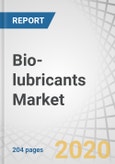Stringent regulations and growing acceptance among end-users is projected to drive the bio-lubricants market
The global bio-lubricants industry has witnessed growth primarily because of the strict regulations adopted by countries across the world. There has been growing acceptance among end-use industries due to the continuous technological advancement to justify the premium cost of bio-lubricants.
Hydraulic oil application is projected to witness highest CAGR during the forecast period
The hydraulic oil application of the bio-lubricants market is projected to witness the highest growth during the forecast period, both in terms of value and volume. The growth in this segment is attributed to its usage in hydraulic elevators, sweepers, garage trucks, forklifts, motor graders, and end loaders, which are used in many industries.
Industrial segment projected to lead the bio-lubricants market from 2020 to 2025
The industrial segment includes the marine and agriculture & construction industries. These two industries are the largest and fastest-growing end-use industries, respectively. Various regulations such as the vessel general permit (VGP) in the US and EcoLabel in Europe have made it mandatory to use bio-lubricants or environmentally accepted lubricants (EAL) to be used in shipping vessels.
Europe projected to account for the maximum share of bio-lubricants market during the forecast period
Europe is projected to lead the global bio-lubricants market from 2020 to 2025. Stringent regulations and the ongoing transition towards bioeconomy in countries such as Germany, Italy, Nordic countries, Benelux, and France are promoting the use of bio-based chemicals such as bio-lubricants and biofuels, which is driving the market in the region.
In-depth interviews were conducted with Chief Executive Officers (CEOs), marketing directors, innovation and technology directors, and other executives from various key organizations operating in the bio-lubricants market.
- By Company Type: Tier 1: 15%, Tier 2: 55%, and Tier 3: 30%
- By Designation: CXOs: 10%, Managers: 40%, and Executives: 50%
- By Region: North America: 10%, Europe: 15%, Asia Pacific: 65%, Middle East & Africa: 5%, and South America: 5%
The global bio-lubricants market comprises major manufacturers such as ExxonMobil (US), Royal Dutch Shell (Netherlands), Total S.A (France), Cargill Inc. (US), BP (UK), FUCHS Group (Germany), and Panolin AG (Switzerland).
Research Coverage
The market study covers the bio-lubricants market across various segments. It aims at estimating the market size and the growth potential of this market across different segments based on type, material, application, and region. The study also includes an in-depth competitive analysis of key players in the market, along with their company profiles, key observations related to their products and business offerings, recent developments undertaken by them, and key growth strategies adopted by them to enhance their position in the bio-lubricants market.
Key Benefits of Buying the Report
The report is expected to help the market leaders/new entrants in this market with information on the closest approximations of the revenue numbers of the overall bio-lubricants market and its segments and sub-segments. This report is projected to help stakeholders understand the competitive landscape of the market and gain insights to improve the position of their businesses and plan suitable go-to-market strategies. The report also aims at helping stakeholders understand the pulse of the market and provides them with information on the key market drivers, challenges, and opportunities.
Table of Contents
Companies Mentioned
- Advonex International
- Albemarle Corporation
- Balmer Lawrie
- Binol Lubricants
- Biona Jersín S.R.O.
- BP Plc
- Carl Bechem
- Chevron Corporation
- Emery Oleochemicals
- Fuchs Petrolub AG
- Green Earth Technologies Inc.
- Igol Lubricants
- Kajo Chemie
- Klüber Lubrication München Se & Co. Kg
- Magna Group
- Mint Biofuels Ltd
- Panolin AG
- Polnox Corporation
- Renewable Lubricants
- Rowe Mineralolwerk Gmbh
- Royal Dutch Shell Plc
- RSC Bio Solutions
- Total SA
- Vickers Oil
Methodology

LOADING...








